
Chatham County is a county located in the Piedmont area of the U.S. state of North Carolina. As of the 2010 census, the population was 63,505. Its county seat is Pittsboro.
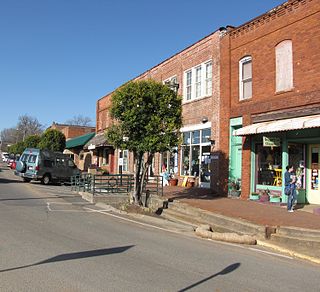
Pittsboro is a town in Chatham County, North Carolina, United States. The population was 3,743 at the 2010 census and estimated to 4,287 at the 2018 Population Estimates Program (PEP) of the U.S. Census Bureau. It is the county seat of Chatham County.

The town of Hillsborough is the county seat of Orange County, North Carolina, United States and is located along the Eno River. The population was 6,087 in 2010.
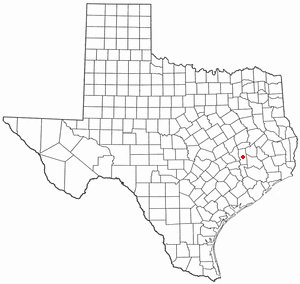
Anderson is a city and county seat of Grimes County, Texas, United States. The population was 222 as of the 2010 census. The town and its surroundings are listed on the National Register of Historic Places as the Anderson Historic District.

Bynum is an unincorporated community in northeastern Chatham County, North Carolina, United States on the banks of the Haw River. Bynum is five miles north of Pittsboro and 11 miles south of Chapel Hill. It is also known as Bynum Mill Village or Bynum Mill Hill.

John Steele was a planter, Federalist legislator, comptroller of the U.S. Treasury, and member of the United States House of Representatives from the state of North Carolina between 1790 and 1793.

Daniel C. Cooper was an American surveyor, farmer, miller and political leader.

The George H. Gurler House or simply, the Gurler House, is a home in the DeKalb County, Illinois city of DeKalb. The home is listed on the National Register of Historic Places to which it was added in 1979. The home was built in 1857 and was occupied by members of George H. Gurler's extended family as early as 1888. Gurler was the co-founder of the Gurler Brothers Creamery. Gurler was also the president of the DeKalb County Farmer's Institute, the predecessor of the American Farm Bureau Federation.
Freeman House or variations such as Freeman Farm may refer to:

The Lee–Fendall House is a historic house museum and garden located in Old Town Alexandria, Virginia at 614 Oronoco Street. Since its construction in 1785 the house has served as home to thirty-seven members of the Lee family (1785–1903), hundreds of convalescing Union soldiers (1863–1865), the prominent Downham family (1903–1937), the family of powerful labor leader John L. Lewis (1937–1969), and enslaved or free servants of those families.

Oldfields also known as Lilly House and Gardens, is a 26-acre historic estate and house museum at Newfields in Indianapolis, Indiana, United States. The estate, an example of the American country house movement of the late 19th and early 20th centuries, was designated a U.S. National Historic Landmark in 2003.

The King Store and Homestead are historic buildings located at 209 and 211 Main Street, in the Ledgewood section of Roxbury Township, in Morris County, New Jersey. The Roxbury Historic Trust acts as curator for these Roxbury Township owned buildings. They were purchased by the Township with Green Acres funding. The buildings were added to the National Register of Historic Places on April 29, 1994, for their significance in commerce from 1815 to 1928. Both were later added as contributing properties to the Ledgewood Historic District on April 18, 2013.
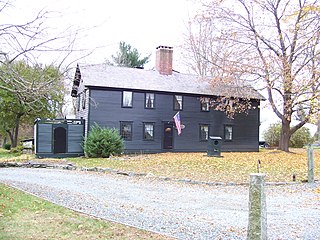
The Stephen Northup House is a historic house at 99 Featherbed Lane in North Kingstown, Rhode Island.

The Mount Pleasant Historic District encompasses the historic center of the village of Mount Pleasant, Ohio. Founded in 1803 by anti-slavery Quakers, the village was an early center of abolitionist activity and a well-known haven for fugitive slaves on the Underground Railroad. The village center is relatively little altered since the antebellum period. The district was listed on the National Register of Historic Districts in 1974, and was designated a National Historic Landmark in 2005.
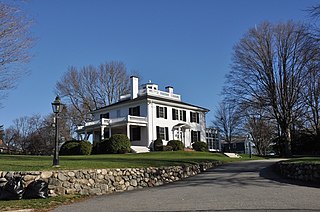
Beebe Homestead, also known as the Lucius Beebe House and Beebe Farm, is a historic Federal period home at 142 Main Street in Wakefield, Massachusetts, which was built during the federal era that extended from the late 18th-century into the 1820s. It is suspected to have been remodeled into the federal style from an earlier home built in circa 1727. It overlooks Lake Quannapowitt, and according to a 1989 study of historic sites in Wakefield, the house is "one of Wakefield's most imposing landmarks." The property was added to the National Register of Historic Places in 1989.

The Mary and Eliza Freeman Houses are historic residences in Bridgeport, Connecticut. The simple, clapboard-covered dwellings were built in 1848 in what became known as Little Liberia, a neighborhood settled by free blacks starting in the first quarter of the nineteenth century. As the last surviving houses of this neighborhood on their original foundations, these were added to the National Register of Historic Places on February 22, 1999. The houses are the oldest remaining houses in Connecticut built by free blacks, before the state completed its gradual abolition of slavery in 1848. The homes and nearby Walter's Memorial A.M.E. Zion Church are also listed sites on the Connecticut Freedom Trail.
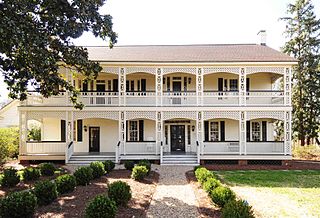
The White Home in Rock Hill, South Carolina is a small historical museum. Five generations of the White family lived in the house between 1837 and 2005. Over the years, the home transformed from a one-room cottage into an eighteen-room, two story house. It is located in the Reid Street-North Confederate Avenue Area Historic District.

The House in the Horseshoe, also known as the Alston House, is a historic house in Glendon, North Carolina in Moore County, and a historic site managed by the North Carolina Department of Natural and Cultural Resources' Historic Sites division. The home, built in 1772 by Philip Alston, was the site of a battle between loyalists under the command of David Fanning and patriot militiamen under Alston's command on either July 29 or August 5, 1781. The battle ended with Alston's surrender to Fanning, in which Alston's wife negotiated the terms with the loyalists.
Houstonville is an unincorporated community in the Eagle Mills Township of Iredell County, North Carolina, United States. Houstonville is located on U.S. Route 21, 3.3 miles (5.3 km) north of Harmony. Houstonville was founded in 1789 by Christopher Houston and is the second oldest town in Iredell County after the county seat, Statesville.
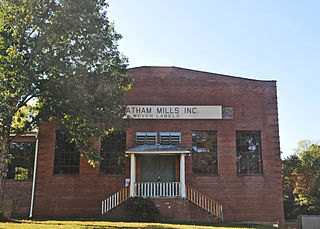
Pittsboro Historic District is a national historic district located at Pittsboro, Chatham County, North Carolina. The district encompasses 131 contributing buildings, 3 contributing sites, and 1 contributing object in the county seat of Pittsboro. Located in the district and separately listed are the Chatham County Courthouse, the Hall-London House, the Moore-Manning House, the Reid House, the Lewis Freeman House, the McClenahan House, and the Patrick St. Lawrence House. Other notable buildings include the Blair Hotel, Pilkington Drug Store / S & T' s Soda Shoppe, Justice Motor Company building (1949), St. Bartholomew's Episcopal Church (1832), Pittsboro United Methodist Church, and Queen Anne style Henry H. Fike House.





















